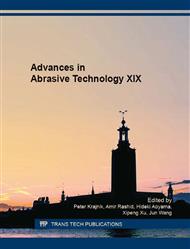p.40
p.46
p.52
p.59
p.64
p.70
p.79
p.85
p.91
Adaptive Grinding Strategy Development
Abstract:
Grinding performance can be influenced by various grinding conditions including workpiece materials properties, grinding wheel properties, grinding operational parameters and dressing operational parameters. In order to achieve stable optimal grinding performance, it is important to select the most suitable operational control parameters to match grinding requirement and to minimize the effects of grinding wheel wear and other changes in the process environment. The paper presents a simple adaptive control logic strategy for the selection of dressing and grinding conditions based on available sensing techniques. In this study, desirable grinding behaviour is discussed to demonstrate how to extract useful process information to guide process parameter adjustment for a stable satisfactory grinding performance.
Info:
Periodical:
Pages:
64-69
Citation:
Online since:
October 2016
Authors:
Keywords:
Price:
Сopyright:
© 2016 Trans Tech Publications Ltd. All Rights Reserved
Share:
Citation:


